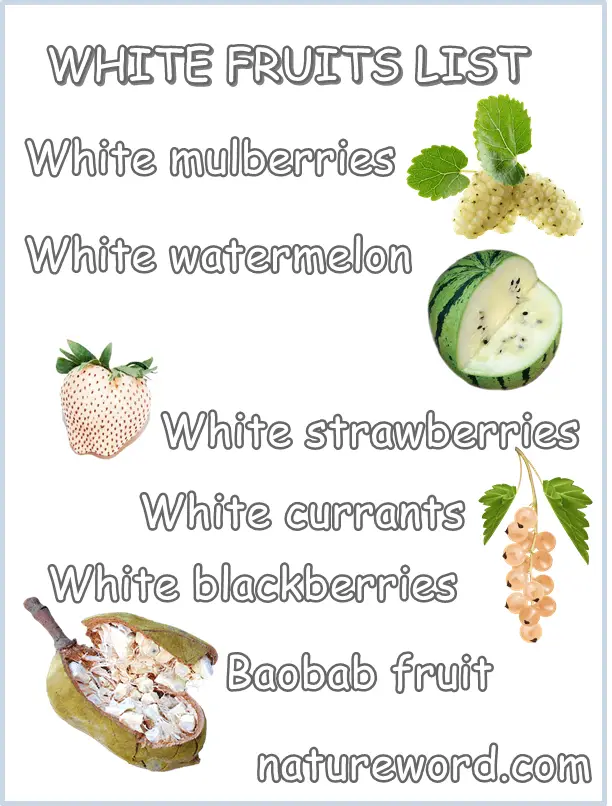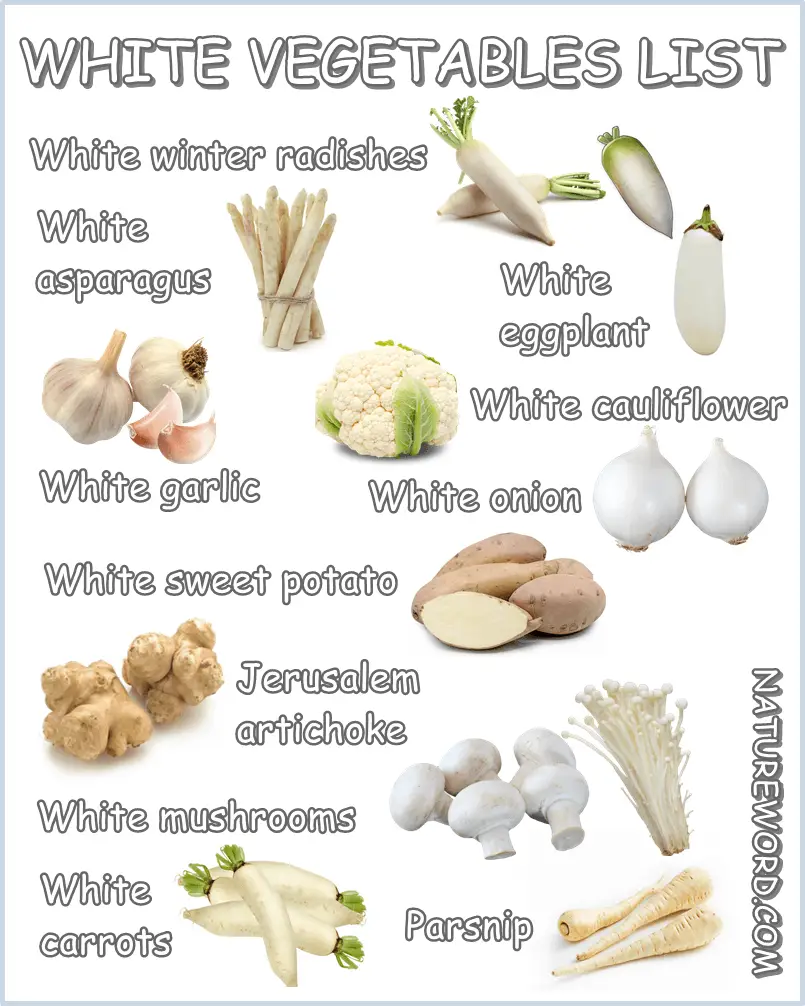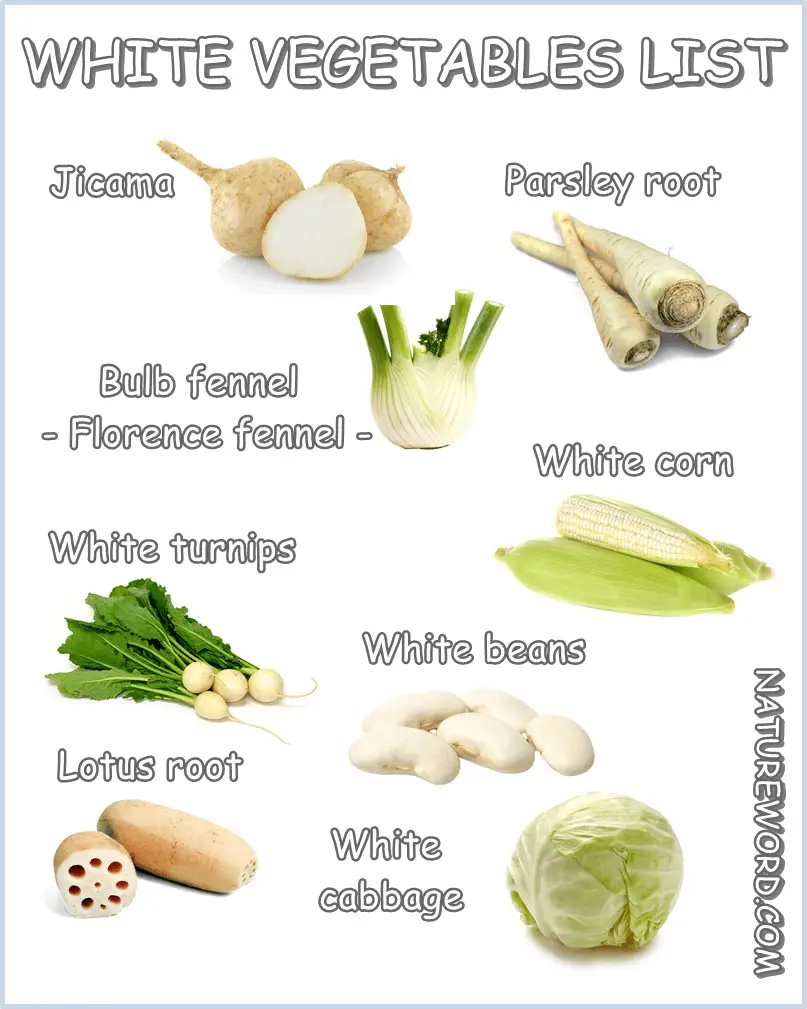White fruits and vegetables are extremely healthy despite everyone gravitating towards the darkest food colors. While they lack the antioxidants that give blue and purple and red foods their striking colors, and also the sharp flavor notes that come with them, white fruits and vegetables are just as good for you and worth including in your diet.
From highly bioactive constituents with proven anticancer effects to anti-inflammatory benefits and a good nutritional value, white foods have it all.
1) White watermelon
White watermelon is a white fleshed variety of watermelon that tastes just as good as red and yellow watermelon, some varieties being even more sweet, and is just as healthy. In season right now, white watermelon is a hydrating food for summer and good to eat is you have high blood pressure because of its content of potassium and the fact that it’s sodium free. Citrulline in white watermelon also holds benefits for blood circulation and exercise performance.

2) White strawberries
White strawberries are an enchanting view: crisp white with red seed dots, sometimes blushed lightly with pink, you want to eat them and at the same time not eat them. White strawberries are high in vitamin C and have anti-inflammatory properties. They are a good food to eat for arthritis, and help improve bone mineral density.
3) White mulberries
Mulberries are not just edible, but also perfectly safe to eat raw, cooked and otherwise processed (e.g. jam, dried). White mulberries, Morus alba, are juicy and taste honey-sweet, with delicious fruity flavors. Not just this, but they are good for you. White mulberries are naturally high in vitamin C with over 40% of daily values per 100 grams, and have anti-inflammatory benefits. White mulberries also have a good content of iron for a boost in energy levels and vitality.
4) White currants
White currants are actually a variety of red currants, but which do not develop the typical red pigment. Instead they are translucent white with very thin skin which allows you to see the seeds inside.
White currants are good to eat because they have a sweeter, less sharp taste and are high in vitamin C with antiaging and anti-inflammatory benefits.

5) White winter radishes
White winter radishes are radishes that are naturally in season late fall through winter and they are all white, or almost completely white, except for the top part which may be light green (e.g. the Daikon radish). They are grown covered with soil so as to not develop pigment. In addition to a spectacular sight, white winter radishes are one of the healthiest white foods you can eat with scientifically proven anticancer effects and anti-inflammatory benefits.
6) White eggplant
Natural eggplant season is almost here and white eggplants are a great option for a white summer food. White eggplants are modestly nutritious, but very low in calories and a great food to eat if you are looking to lose weight. White eggplants are especially good to eat during hot summer days because they have potassium and magnesium to lower blood pressure numbers and exert a cardioprotective action.
7) White asparagus
White asparagus is a blanched variety of asparagus grown underground, covered with soil, so that it doesn’t develop any color and stays pearly white. Why? Because white foods look amazing on the plate, classy and appealing. White asparagus is just as healthy as other green and purple asparagus. It’s a good food to eat for weight loss as it’s very low in carbs, sugar, fat and calories.
White asparagus also has anticancer properties – research showed a methanolic extract of white asparagus activated apoptosis in colon cancer cells as well as reduced inflammatory markers.
8) White cauliflower
The winter seasonal, white cauliflower, is a traditional cold season food that finds its way in the most delicious of dishes. White cauliflower is a source of organic sulfur compounds with proven anticancer effects and naturally high in vitamin C with anti-inflammatory benefits. White cauliflower is a good food to eat for diabetes because it’s low glycemic and has limited effects on blood sugar as a result. You can use it as a substitute for mashed potatoes.
9) White bulb onion
White bulb onion is one of those foods in season all year round and a staple vegetable, the heart and soul of every savory dish. What it lacks in color, it make up for in highly bioactive organic sulfur constituents with anti-inflammatory and anticancer properties. But do feel free to try red onion which is just as healthy.
10) White garlic
Of all the white foods out there, white garlic is a go-to for flavor and health benefits. White inside and out, garlic is more of a white condiment than white vegetable, if it’s culinary uses are to be taken into account.
Garlic is a source of anticancer compounds and has proven natural antibiotic effects. However, avoid garlic if you have an active gastritis or GERD, but if you don’t, make sure you try red garlic too.
And if you’ve had it with white foods, turn your boring white garlic into the spectacular and healthy black garlic.

11) White sweet potatoes
When you hear sweet potatoes, your mind likely pictures the deep orange-fleshed variety. But sweet potatoes come in all sorts of colors, including purple sweet potatoes, red sweet potatoes, yellow sweet potatoes and, of course, white sweet potatoes. White sweet potatoes count as a white colored food, but know that only the flesh is white. The potato skin is a boring earthy brown.
The lack of color of white sweet potatoes indicates a very low content of vitamin A as opposed to the more common orange fleshed sweet potato which is naturally high in provitamin A.
But white sweet potatoes have a good content of B vitamins and natural sugars for both long-lasting and quick energy and are good for high blood pressure and high cholesterol.
12) Jerusalem artichokes
The Jerusalem artichoke is crisp white inside with a light cream-brown skin. The tubers are known for their allergenic potential and should be avoided by anyone who is allergic.
At the same time, Jerusalem artichokes have high blood pressure lowering benefits and benefits for high cholesterol. Not just this, but they exert strong prebiotic effects and are a good food to eat for gut bacteria imbalance and bowel health.
13) Parsnip
Parsnip is creamy-white to off-white on the outside and white on the inside so it counts as a white food. While not a favorite among vegetables, parsnip is extremely healthy. Studies show parsnip has anticancer benefits – falcarinol, farcalindiol, methyl-falcarindiol and panaxydiol are natural constituents in parsnip with proven anticancer effects.
14) White carrots
White carrots actually precede today’s orange carrots and are enjoying a comeback these days. Despite lacking the pigments that give red carrots, yellow carrots, purple and black carrots their color and benefits, white carrots are still healthy. White carrots are an anticancer food, provide quick energy for the body to use in the form of natural sugars and help combat fatigue with a good content of vitamin B6.
15) Parsley root
Have you ever had parsley root? Root parsley is an all white root vegetable, similar in appearance to white carrots, but more closely resembling parsnip in taste in the sense that it’s mild tasting, but very fragrant. Parsley root shares in the benefits of both white carrots and parsnip as it is a food with anticancer activity. Natural components in parsley root have been shown to protect against colon cancer and acute lymphoblastic leukemia, inhibiting tumor growth.

16) Jicama
Jicama is a root vegetable with crisp white flesh and light to medium brown skin so it can pass as a white food. The turnip like vegetable has a pleasant and mild sweet taste with earthy notes and makes a great substitute for potatoes. Jicama is low in calories, but filling, and helps with weight loss. Eating it raw provides good amounts of vitamin C to the diet and anti-inflammatory and antioxidant benefits.
17) Mushrooms
There are a lot of edible white mushrooms, from the popular white button mushrooms or white portobello mushrooms to enokitake or enoki mushrooms. While otherwise mildly nutritious, mushrooms, white and other colors, are one of the few foods that naturally have vitamin D. Mushrooms contain a form of vitamin D called vitamin D4.
Eating white mushrooms is good for immunity – vitamin D in the culinary vegetable modulates the immune system for an optimal response, increases resistance to infection and reduces risks of certain cancers, according to research. Eating white mushrooms also helps preserve cognitive function and prevent premature cognitive decline and is good for fertility and thyroid health.
18) Bulb fennel
Bulb fennel may or may not count as a white vegetable in your eyes and that is because, while the bulb itself is a beautiful crisp white color, the stems coming out of it are light green.
Also called Florence fennel, the vegetable is a staple in Italian cuisine. In addition to adding flavor to dishes, bulb fennel is also low in calories and good for weight loss. Not just this, but the aromatic oils that give the fennel bulb its fragrance have antibacterial properties.
19) Baobab fruit
The Baobab fruit is the fruit of the might Baobab trees. White inside, but brown on the outside, it counts as a white food in some circles. The white Baobab fruit are a source of vitamin C with anti-inflammatory and antioxidant benefits and benefits for wound healing.
20) White corn
White corn is a variety of corn with pearly white kernels. The white vegetable boasts a good content of several B vitamins for a boost in energy and vitality. White corn is a good food to eat for high blood pressure thanks to a good content potassium and magnesium. It’s also good for high cholesterol due to a good content of dietary fiber and holds benefits for bone density.
21) White turnips
Turnips that are white all over exist and are one of the healthiest foods you can eat. Yes, turnips are not very appealing taste-wise, but did you know they are an excellent anticancer food? Turnips also make a good mashed potatoes substitute if you’re looking for a lower glycemic mashed potatoes version for better blood sugar control.
22) Lotus root
Lotus root is the root of the beautiful lotus flower and a culinary vegetable. It’s light brown on the outside and completely white inside, although very young roots are completely white. Lotus root is in season right now (lotus root season starts in April and lasts until September) and a good food to eat for bone density. Lotus root has blood pressure lowering effects and boosts energy levels and vitality.
23) White beans
White beans are one of the healthiest white foods you can eat. High in protein, they provide benefits for the brain and nervous system and support muscle function and muscle gain. White beans are also good for energy metabolism and contribute to skin health via a good content of B vitamins. But one of the biggest benefits of eating white beans is constipation relief.
24) White blackberries
White blackberries are a novel variety of blackberries that are crisp white or a cream to off-white color, similar to overripe white mulberries. Because of the lack of pigmented anthocyanin antioxidants that give blackberries their color, white blackberries taste sweeter and less sharp or less acidic than their counterpart.
White blackberries have a good content of dietary fiber and contribute to bowel health by supporting good gut bacteria populations. Low in calories, they make a great food to eat for weight loss. White blackberries are also a good source of vitamin C with anti-inflammatory benefits and benefits for teeth and gums health and hold minor blood pressure lowering benefits.
25) White cabbage
White cabbage is completely white inside, despite having one or a few layers of pale green leaves on the outside. Whether it’s a white vegetable by all standards or not, white cabbage is a healthy food. It’s a source of organic sulfur compounds with proven anticancer properties and rich in digestible and indigestible fiber with important prebiotic benefits for gut bacteria imbalance. White cabbage is one of the most nutritious white foods, high in vitamin C and K, vitamins B6 and B9.
